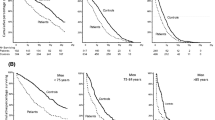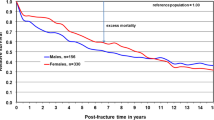Abstract:
Hip fracture is associated with a higher mortality rate in men than in women. However, mean age of men and women with hip fracture differs markedly. Thus, some of the differences in the clinical pattern and outcome between genders could be related to different ages. To avoid the influence of age on gender-specific outcome, we analyzed prefracture conditions and hip fracture outcome in a cohort of men and of age-matched women. Risk factors for low bone mass were recorded in 106 men (mean age ± SD, 80.3 ± 9.3 years) and 264 age-matched women (mean age 81.4 ± 8.0) with hip fracture. We compared mortality rate, survival, years of potential life lost and modification of housing conditions. These outcomes were prospectively assessed during an average 3.6 years follow-up (up to 7 years). Men with hip fracture differed from age-matched hip-fractured women by a higher alcohol and tobacco consumption, a greater frequency of living in couple, and by less prevalent fractures. Mortality rate after hip fracture was significantly higher in men (RR = 1.74, 95% CI 1.34–2.24). Since mortality is higher in the general male population, we compared reduction in life expectancy taking into account the gender-specific mortality rate. The excess mortality in each age-group of hip-fractured patients, which was measured during the whole follow-up period, and is an estimate of death attributable to fracture, did not differ between genders. Reduction in life expectancy due to hip fracture was similar in both genders (5.9 ± 4.5 and 5.8 ± 4.8 years, in men and women, respectively; NS), but the proportion of the years of life lost was higher in men (70 ± 33%) than in women (59 ± 42%, p < 0.01). It was concluded that for the same age, mortality rate after hip fracture was higher in men than in women. Although the reduction in life expectancy was similar in both genders, the proportion of the years of life lost was higher in men, suggesting a worse impact of hip fracture on survival in men, even after consideration of the higher mortality rate in the general male population.
Similar content being viewed by others
Author information
Authors and Affiliations
Additional information
Received: 9 October 2001 / Accepted: 22 April 2002
Rights and permissions
About this article
Cite this article
Trombetti, A., Herrmann, F., Hoffmeyer, P. et al. Survival and Potential Years of Life Lost After Hip Fracture in Men and Age-matched Women . Osteoporos Int 13, 731–737 (2002). https://doi.org/10.1007/s001980200100
Published:
Issue Date:
DOI: https://doi.org/10.1007/s001980200100




